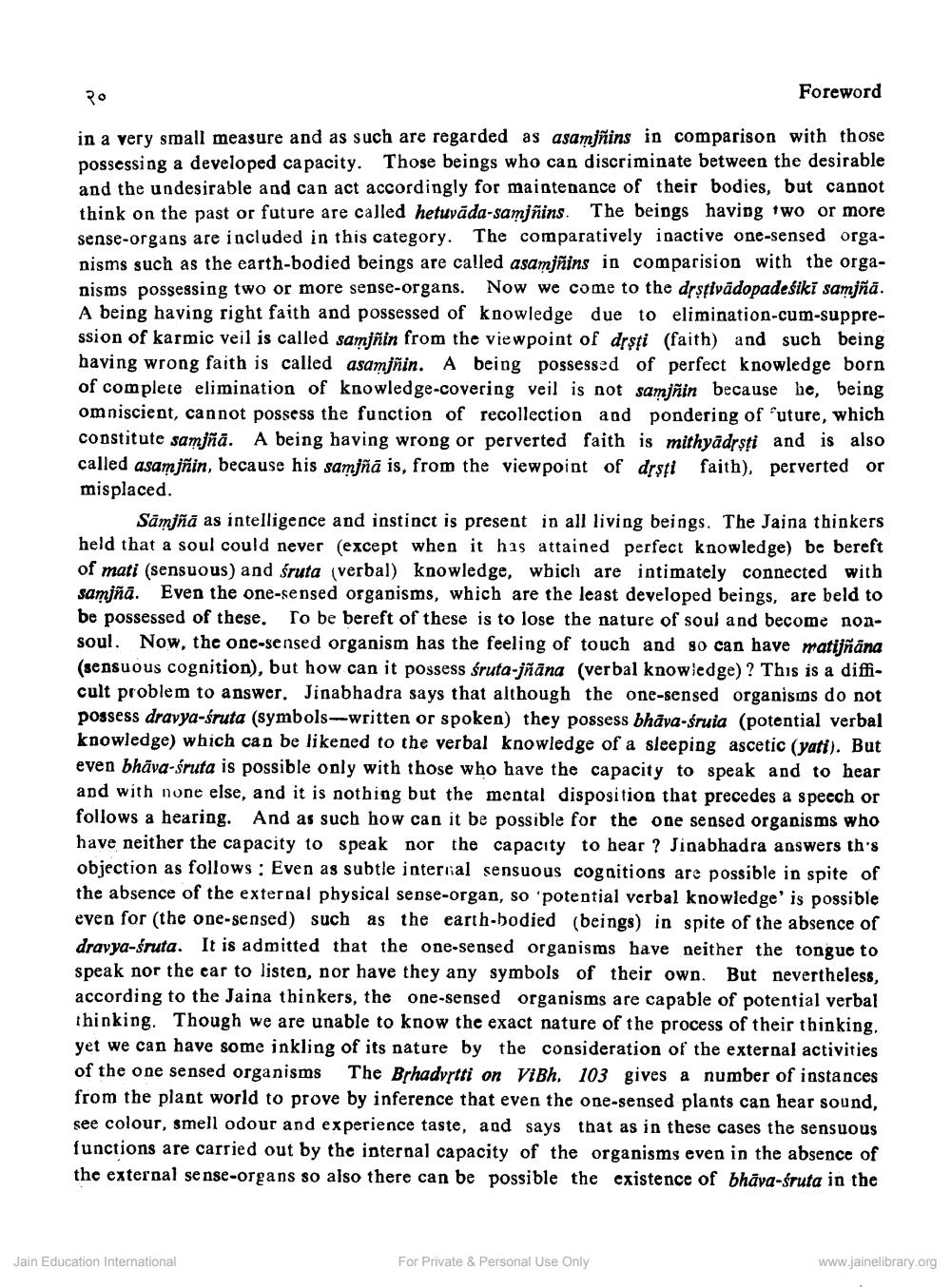________________
२०
Foreword
in a very small measure and as such are regarded as asamjñins in comparison with those possessing a developed capacity. Those beings who can discriminate between the desirable and the undesirable and can act accordingly for maintenance of their bodies, but cannot think on the past or future are called hetuvāda-samjñins. The beings having two or more sense-organs are included in this category. The comparatively inactive one-sensed organisms such as the earth-bodied beings are called asamjñins in comparision with the organisms possessing two or more sense-organs. Now we come to the drstivādopadefiki samjñā. A being having right faith and possessed of knowledge due to elimination-cum-suppression of karmic veil is called samjñin from the viewpoint of drsti (faith) and such being having wrong faith is called asamjñin. A being possessed of perfect knowledge born of complete elimination of knowledge-covering veil is not samjñin because he, being omniscient, cannot possess the function of recollection and pondering of future, which constitute samjñā. A being having wrong or perverted faith is mithyādrsti and is also called asamjñin, because his samjñā is, from the viewpoint of drsti fajth), perverted or misplaced.
Sämjñā as intelligence and instinct is present in all living beings. The Jaina thinkers held that a soul could never (except when it his attained perfect knowledge) be bereft of mati (sensuous) and śruta (verbal) knowledge, wbich are intimately connected with samjñā. Even the one-sensed organisms, which are the least developed beings, are beld to be possessed of these. To be bereft of these is to lose the nature of soul and become nonsoul. Now, the one-sensed organism has the feeling of touch and so can have matijñana (sensuous cognition), but how can it possess śruta-jñāna (verbal knowledge)? This is a difficult problem to answer. Jinabhadra says that although the one-sensed organisms do not possess dravya-śruta (symbols-written or spoken) they possess bhāya-śruia (potential verbal knowledge) which can be likened to the verbal knowledge of a sleeping ascetic (yati). But even bhāva-śruta is possible only with those who have the capacity to speak and to hear and with none else, and it is nothing but the mental disposition that precedes a speech or follows a hearing. And as such how can it be possible for the one sensed organisms who have neither the capacity to speak nor the capacity to hear ? Jinabhadra answers th's objection as follows: Even as subtle internal sensuous cognitions are possible in spite of the absence of the external physical sense-organ, so 'potential verbal knowledge' is possible even for (the one-sensed) such as the earth-bodied (beings) in spite of the absence of dravya-śruta. It is admitted that the one-sensed organisms have neither the tongue to speak nor the car to listen, nor have they any symbols of their own. But nevertheless, according to the Jaina thinkers, the one-sensed organisms are capable of potential verbal thinking. Though we are unable to know the exact nature of the process of their thinking. yet we can have some inkling of its nature by the consideration of the external activities of the one sensed organisms The Brhadvrtti on Vibh, 103 gives a number of instances from the plant world to prove by inference that even the one-sensed plants can hear sound, see colour, smell odour and experience taste, and says that as in these cases the sensuous functions are carried out by the internal capacity of the organisms even in the absence of the external sense-organs so also there can be possible the existence of bhāva-śruta in the
Jain Education International
For Private & Personal Use Only
www.jainelibrary.org




